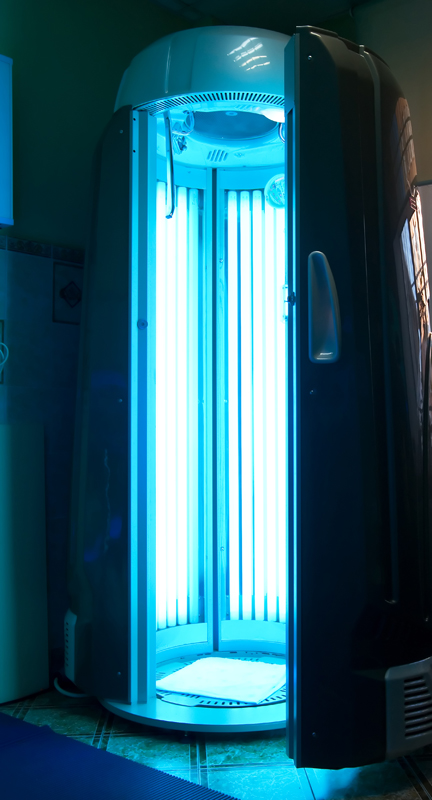Tanning brings negative effects, pressure

Women and men across the United States are turning to tanning to achieve a “healthy glow.” Tanning beds are used by countless teenagers, along with spray tans and bronzing lotion (the safest ways to darken skin). Tanning became commonplace with the introduction of silver metallic UV reflectors in the 1950s and continued growing well into the 21st century. Sporting a tan was seen as the result of having enough time and daring to sunbathe, two attractive traits, along with the golden skin, which made them look like they were on a perpetual luxury vacation on the beach.
Today, boasting tan skin sends a message to the world: you’re desirable, but that message brings along many negative side effects — tanning is proven to dramatically increase the risk of skin cancer, along with premature aging. So why the pressure on teenagers to have a certain skin color?
The suntan business is a $5 billion industry, directing most of its advertising at caucasian girls and women from age 16 to 29. St. Tropez, a popular self-tanning brand, sells three bottles of bronzing lotion a minute around the world. Granted, bronzing lotion or a spray tan are much safer alternatives than being exposed to UVA and UVB rays from a tanning bed, but they still send the message that it’s not OK to have a skin color other than tan. The tanning industry simply encourages customers that perfection and desirability can finally be achieved if they’ve got that sun-kissed look. Meanwhile, women in Asia and Nigeria use skin lightening creams to whiten their skin. Whether they’re hoping to be bronzed and whitened, they’re buying into what their culture deems superior.
Tanners seem to know that their guilty pleasure brings advanced signs of aging like dark spots and wrinkles but continue to do it anyways. According to the Skin Cancer Foundation, more than 90 percent of the visible changes commonly attributed to skin aging are caused by the sun. The multi-billion tanning industry creates an profitable cycle. Use a tanning bed to achieve a sun-kissed glow evolves into premature aging (or possibly melanoma, a deadly skin cancer). Premature aging leads to expensive creams and serums to fill in wrinkles and fade dark spots.
I come from Irish and German heritage, which gave me red hair and a pale exterior prone to sunburns and freckles. In my few years of purchasing makeup, I’ve learned that I don’t need to test out a color on my skin — I automatically go for the lightest shade of tinted moisturizer manufactured (but even that can leave an orange streak on my face). I’ve been referred to as a ghost, albino and pasty, and possess the useful talent of glowing under black lights. So, in terms of skin, I’ve won the genetic lottery, right? Well, why not.
Whether you’re as pale as skim milk or as dark as the night sky, every skin color has a rich history behind it. Your particular skin tone is the culmination of generations of people joined together creating life, in good times and in bad. It’s one of the most unique things the world can offer you. Tan is beautiful. Pale is beautiful. Black is beautiful. Every possible color combination and genetic variation is special and deserves a little love.
Collective thought about skin color seems to have amounted to “A tan means you’re healthy,” when in reality, the results are much different. A tan actually equates to damaged skin. Over time, prolonged exposure to the sun breaks down collagen, which gives skin the ability to bounce back after damage and resist the effects of gravity over time. The body stops collagen production around the end of puberty, meaning you have a limited supply for the rest of your life. It’s skins’ way of saying, “Treat me right!”
The actual color of a tan comes from injury to the skin. Skin responds to sun and ultraviolet damage by producing more pigment, called melatonin. Ultraviolet radiation is a known carcinogen that causes cancer — no wonder dermatologists encourage the public to check for suspicious miles of freckles on their skin. These spots can be melanoma, a dangerous cancer. Even after removal of a cancerous spot, it can spread to vital organs and have deadly consequences. Cancer might be the last thing on the mind of someone lying out in the sun, but it’s a real danger looming up in the sky. The risk of melanoma goes up 87 percent after one tanning bed use under the age of 35, so next time a tanning salon says that tanning is “Mother Nature’s sunscreen,” keep the very real risks of cancer in mind.
Skin is very personal. It tells stories of acne scars from teenage years, wrinkles from smiling, cuts from the first time shaving and bruises from the soccer field. Americans spend billions on beauty products each year pampering it. Tans might be glamorous for now, but treating your skin right is forever. It protects the most vital organs that make you, well, you. After all, it’s what’s inside that counts.








You must be logged in to post a comment Login